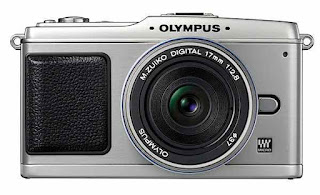Olympus Pen E-P1 Manual
 |
| Olympus Pen E-P1 Manual |
This Olympus Pen E-P1 camera combines the advantages of two photo albums with its elegant metal housing: the flexibility and image quality of the SLR photography, as well as the ease and simplicity of the compact photographs. Experience the 335 g light digital PEN, its powerful interchangeable lenses as well as the extensive accessories. And take photos like you've always wanted to do. So compact, so easy or Simple photography, anytime and anywhere, the very first PEN caused a sensation at the premiere in 1959. No wonder your concept was revolutionary. Because this camera made the photograph as simple as writing with a pen (pen). The new digital PEN is inspired by the same idea. And like its analog predecessors, it is ultra compact. At that time, the small dimensions were the result of the half-molding technique, in which exposures were exposed in half the 35 mm format. Today, in the digital PEN, it is the new Micro Four Thirds standard, which allows for minimizing the camera size without sacrificing performance. The new digital PEN is as handy and practical as the analogue PEN, which was the light of the world 50 years ago.
In the case of mirror reflex cameras, the image to be recorded is captured by the lens, reflected by a mirror and a pentaprism, and displayed in the viewfinder display. It is this design that prevents SLRs from being scaled down. And it explains why only a fundamentally new defined recording standard can break these limitations. Like the Micro Four Thirds system, which works entirely without a mirror and differs in many other details. Among other things, the exposure distance (the distance between the lens connector and the image sensor) is halved - with the image sensor (Four Thirds) unchanged. In addition, the diameter of the bayonet connector was reduced by 6 mm, without adversely affecting the size of the luminous flux. This is why the Micro Four Thirds System can be used to develop considerably smaller and slimmer cameras as well as more compact lenses that meet the highest image quality requirements. The Olympus Pen E-P1 presents itself unconventionally in terms of size, shape, and design, it also offers a unique creative potential. With Live View, you can see the settings and effects you have chosen before recording. And the kind of filters opens up interesting new photography style on finger pressure. You love to make your motifs fit? Then test the multi-aspect function. You can even produce videos with the PEN in high definition and SLR image quality. Also on the go. Thanks to the Micro Four Thirds system, you can have the handy PEN anywhere. So you will not miss one of the endless opportunities to capture your vision of the world in impressive images.
The Olympus Pen E-P1 allows you to shoot HD-quality movies in 16: 9 widescreen format (1280 x 720, 30 frames per second) or in 4: 3 format (640 x 480, 30 frames per second) in SD quality. It is stored in the AVI format Motion JPEG so that the results can be easily played on the PC. Since the image sensor is much larger than the sensor in HD video cameras, the PEN provides even better picture quality. By adjusting the aperture or using a different lens, you can achieve numerous effects that you can only see from shooting with interchangeable lenses, such as the dramatic use of the depth of field or fascinating perspectives. The integrated electronic image stabilizer is used independently of the lens used. The type filters can also be used for moving images so you can give your films a special style. In addition, with the function for film and still image recording, individual images can be continuously saved as film images. So you are recording a movie while you wait for the right shutter moment.
The Olympus Pen E-P1 is as easy to use as a compact camera. It features an ultra-fast 11-point contrast AF as well as a 3.0-inch LC display with a viewing angle of 176 ° from all directions and clear display even in direct sunlight. Face detection automatically detects and focuses faces. The brightness of the faces and the background is automatically adjusted correctly with the shadow brightener. To enable you to easily adjust the settings while shooting, but still focus on the shot at the same time, LiveView displays the icons for the recording functions on the LC display. With the main and auxiliary rotary controls, you can select and operate the symbol controls without having to look away from the display, because the effects of the settings are immediately visible in real time on the display.
Download Olympus Pen E-P1 Manual (English)
Download Olympus Pen E-P1 Manual (Español)
Download Olympus Pen E-P1 Manual (Português)
Download Olympus Pen E-P1 System Chart (English, Français, Español)
0 Response to "Olympus Pen E-P1 Manual"
Post a Comment